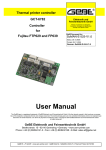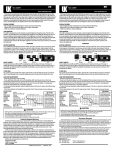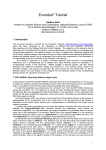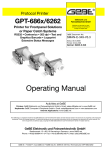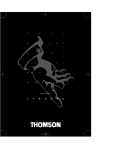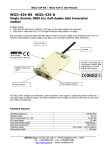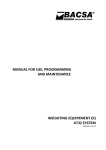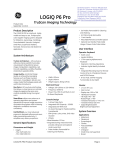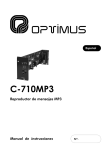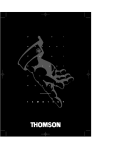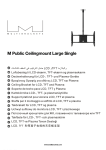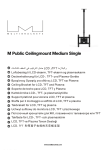Download User manual - GeBE Elektronik und Feinwerktechnik GmbH
Transcript
User manual Elektronik und Feinwerktechnik GmbH Module und Geräte zum Eingeben, Auswerten, Anzeigen und Ausdrucken analoger und digitaler Daten. GeBE IR-Protocol Infrared-Protocol for GeBE Thermal Printer GeBE Document-No. MAN-E-395-V2.0 Status: 25.07.2002 Printed: 03.09.2002 German: MAN-D-394 • Bi-directional Transfer • Wireless Independence • Handshake Mode • Interference-Safe Errors and changes reserved. The technical data given are non-committal information and do not represent any assurance of certain features. GeBE Elektronik und Feinwerktechnik GmbH Beethovenstr. 15 • 82110 Germering • Germany • www.oem-printer.com Phone:++49 (0) 89/894141-0 • Fax:++49 (0) 89/8402168 • email: [email protected] GeBE E+F GmbH • www.oem-printer.com • User manual • GeBE IR-Protocol Page 1 of 8 Content 0. Introduction 3 1. PC Test Program 3 2. Physical Characteristics 3 2.1. Transfer Mode 3 2.2. Settings 3 3. Data Structure 4 3.1. Packet I 4 3.2. Printer Status Protocol Extension for GE-2998 4 3.2.1. Voltage Results of the Last Battery Test Command 5 3.2.2. Printer Status 5 3.3. Packet II 5 4.1. Transfer Protocol 6 4.2. Receive Protocol 7 5. Timing Diagram 8 GeBE E+F GmbH • www.oem-printer.com • User manual • GeBE IR-Protocol Page 2 of 8 0. Introduction For wireless transfer GeBE offers a convenient infrared interface for a number of GeBE printers. The transfer is based on the SHARP IR protocol. Unlike the IrDA protocol, the Sharp IR protocol does not have any software layers that are used for communication in networks or for controlling the hardware. The Sharp IR is similar to the software layer IrCOMM of the IrDA standard. The Sharp IR provides for a simple and cost-effective optional master-slave connection to integrate the IR protocol itself into existing systems. For operation with a printer, the protocol has been extended to monitor the printer functions. 1. PC Test Program For the first developmental phase GeBE offers a test program. The program allows the transfer of any files through a COM interface to an infrared interface. The system requirements for the program "GeBE-IR-Transmit.exe" are an IBM compatible PC, operating system Win 95 or 98, and a GeBE IR adapter GSW-IR or similar interface that connects to a COM interface. 2. Physical Characteristics 2.1. Transfer Mode The physical transfer is compatible to the IrDA SIR hardware layer. This procedure is used for transfer rates from 2,400 bps to 115 kbps. These speeds correspond with a standard serial interface. The hardware layers IrDA FIR and 4 ppm are not supported. This puts the bit intervals between 417 ±s and 8.7 ±s ( ~ 20±s at 9,600bps). An impulse of 3/16 of the impulse width represents logic 1. The light levels are in a range between 40 mW/sr (milliwatt/steradian) and 500 mW/sr. The distance between host and receiver is specified as 1cm to 1 m. start stop 0 1 0 0 1 1 0 1 0 NRZ DATA 1 IrDA-SIR HIGH = LIGHT TRANSMITTED 2.2. Settings 9,600 baud (2,400 - 115,200 bps possible on request) no parity 1 stop bit infrared impulse length 3/16 bit time ( ~ 20 ±s at 9600bps). ( fixed impulse length of 1.63 ±s is not possible ) After the switch from receive to transmit mode, the IR hardware needs a short time period of about 2ms. We therefore recommend to wait for 3 ms after receiving the last block before sending again. GeBE E+F GmbH • www.oem-printer.com • User manual • GeBE IR-Protocol Page 3 of 8 3. Data Structure There are two types of transmit packets. Packet I is used for the transfer of control commands and messages, see table 1. Packet II is used for transmitting data to the printer. Since the IR units are not defined from the beginning, the transfer of either packet type is initiated with 5 dummy characters (00 Hex) and a START ID (96 Hex). The printer has to process at least two dummy charaters correctly, before the start ID is considered. Afterwards, the packet ID is transferred: 82 Hex for packet I , 81 Hex for packet II. 3.1. Packet I Data Format Packet I: DUMMY START ID PACKET ID DATA Number of Bytes Value 5 1 1 1 00h 96h 82h value see table 1 Example for a transfer request: ENQ DUMMY 00h, 00h, 00h, 00h,00h 3.2. Printer Status START ID 96h, PACKET ID 82h, DATA 05h Protocol Extension for GE-2998 Four additional bytes that indicate the exact printer status are attached to both the SYN and the CAN packet. All four parameters are coded binarily. In old software versions, these bytes should be rejected. SYN Packet: ---------< 5 * NULL > < START-ID > < PACKET1 > < SYN > < Vp-noload > < Vp-load > < Errorflags1 > < Errorflags2 > CAN-Packet: ---------< 5 * NULL> < START-ID > < PACKET1 > < CAN > < Vp-noload > < Vp-load > < Errorflags1 > < Errorflags2 > GeBE E+F GmbH • www.oem-printer.com • User manual • GeBE IR-Protocol Page 4 of 8 3.2.1. Voltage Results of the Last Battery Test Command In printers that have a battery test command, the last measured values are transmitted. Otherwise, these bytes are "0". In order to perform a battery test, the battery test command has to be given in the last packet II. With the next SYN or CAN packet from the printer, the measured values are sent as < Vp-noload > < Vp-load >. You can find the description of the test command in the corresponding printer manual. < Vp-noload > : Gives the no-load battery idle voltage immediately before the last battery test command in binary code. < Vp-load > Gives the load battery voltage after the last battery test command in binary code. 3.2.2. Printer Status The following two bytes < Errorflags1 > < Errorflags2 > report the printer status. Attention: Some printer models do not have all error reports or messages available. In this case, all bits are always set to "0". 3.3. Packet II The maximum data block size is 128 bytes, not including the header. If more than 128 bytes have to be transmitted, they have to be split into several sequential blocks. For every 2-byte value, the low byte will be transferred first (BLOCK No, DLENGTH, CHKSUM). The last block contains the block number FFFF Hex. It does not need to be completely filled to128 bytes. Checksum CHKSUM is the sum (2 bytes ) of all data (DATA 1-128). Example: Content of data block: 15h 24h 01h 55h 63h 77h 43h 77h 8Fh 9Ch sum = 034Eh --> low byte = 4Eh high byte = 03h Data Format Packet II: DUMMY START ID PACKET ID VERSION BLOCK No CTRL CODE DEV CODE ID CODE DLENGTH DATA CHKSUM Number of Bytes Value 5 1 1 1 2 (L/H) 1 1 1 2 (L/H) 1 - 128 2 (L/H) 00h 96h 81h 10h 0001h - FFFFh 01h fixed 40h fixed FEh fixed 0001h - 0200h GeBE E+F GmbH • www.oem-printer.com • User manual • GeBE IR-Protocol Page 5 of 8 Example for a Data Transfer: DUMMY START ID 00h, 00h, 00h, 00h,00h 96h, PACKET ID VERSION 81h, 10h DEV CODE ID CODE DLENGTH DATA 40h FEh, LOW ????h HIGH BLOCK NO LOW HIGH CTRL CODE 01h CHEKSUM LOW HIGH 4. Software Protocol 4.1. Transfer Protocol 4.1.1 The host starts a "session" by transmitting a request ENQ (packet I). The printer confirms the ENQ by transmitting a SYN message. 4.1.2 If the host receives a SYN packet, continue with 4.1.4. 4.1.3 If the host receives a CAN packet, or if the selected power-down time has passed and no SYN packet has been received, the host will end the session. If the host receives any other packet, no packet, or an incomplete packet, it will start transmitting ENQ packets every 0.5 seconds (according to Sharp-IR for 6 minutes). 4.1.4 If the host receives a SYN packet, it will transmit a single packet II and wait for an AKN packet from the printer. 4.1.5 When the host receives an ACK packet, the transmission is regarded as a suc cess. 4.1.6 If the host does not receive an ACK packet or another packet I within 1 second after the transmission of packet II, it will go back to step 4.1.1 and transmit the data again. The repeated data transfer after AKN will only be performed once. If this transmission also goes wrong, the session will be canceled. A BUF packet should initiate several repeats. The number of possible repeated block transfers should not be set too low. We recommend 20 repeats. Since the print speed greatly depends on the operating voltage, the number of re peats should be determined by the lowest occuring voltage. GeBE E+F GmbH • www.oem-printer.com • User manual • GeBE IR-Protocol Page 6 of 8 4.2. Receive Protocol 4.2.1 The receiver is activated by a DUMMY character. After the first recognized DUMMY, it will wait for a packet I with ENQ. If no ENQ is received before the set power-down time has passed, the printer will cancel the session and switch to sleep mode. 4.2.2 If the printer receives an ENQ packet, it will either transmit a SYN packet to continue the session, or a CAN packet to finish the session. 4.2.3 When the printer receives a valid packet II, it will transmit a packet I with ACK. 4.2.4 If an error occurs in packet II, or the time between two bytes is more than one second, the printer will go back to step 4.2.1. without sending an ACK. This will cause the host to transmit packet II again after 1 second. 4.2.5 If the checksum is faulty, the printer will send a packet I with NAK. This will initia te an immediate repeat of packet II by the host. Attention: The data transfer in both directions is only possible "half duplex", because transmitter and receiver both receive the signals sent by the other side plus their own transmit signals. For this reason, the transmitting party has to turn off or filter out the receive signals during transfer. GeBE E+F GmbH • www.oem-printer.com • User manual • GeBE IR-Protocol Page 7 of 8 5. Timing Diagram SEND RECEIVE ENQ( P acket I ) Typ. 0.5 sec. ENQ( P acket I ) ENQ( P acket I ) SYN( P acket I ) ( P acket I I ) M ax. 1 sec. M i n. 3 msec. M ax. 1 sec. 1 st DATA Bl ock ACK( P acket I ) ( P acket I I ) M ax. 1 sec. BUF( P acket I ) 2 nd DATA Bl ock Buffer full !! ( P acket I I ) M ax. 1 sec. ACK( P acket I ) 2 nd DATA Bl ock ( P acket I I ) M ax. 1 sec. ACK( P acket I ) 3 rd DATA Bl ock GeBE E+F GmbH • www.oem-printer.com • User manual • GeBE IR-Protocol Page 8 of 8









